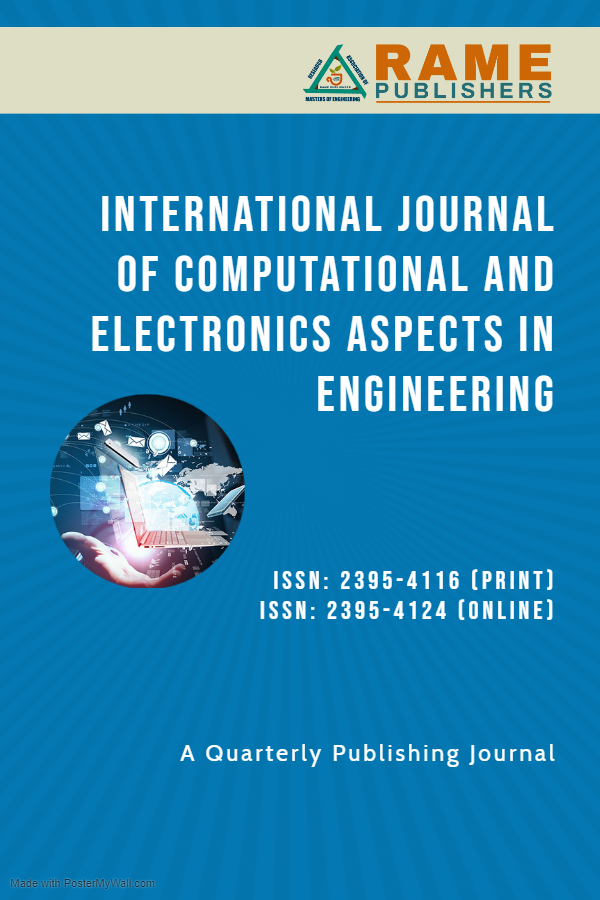Image Compression Process Using Fractional Fourier Transform and Wavelets Techniques
Faris Sattar Hadi
International Journal of Computational and Electronic Aspects in Engineering
Volume 5: Issue 1, March 2024, pp 25-29
Author's Information
Faris Sattar Hadi 1
Corresponding Author
1Information Technology Research and Development Center, University of KUFA, Iraq
Fariss.alkaabi@uokufa.edu.iq
Abstract:-
Compression process is very important for data transfer in information technology. The difficult part of the data compression process is keeping quality of data transferred at high compression ratio. In this research we introduce a new image compression process that uses both fractional Fourier transform and wavelet. While wavelets are the best method for feature extraction from the image, the low frequency of wavelet decomposition are the part in compression process that most of the present methods don’t touch it. On the other hand, fractional Fourier transform is a suitable and helps in the compressed coding of the image. Hence, we have used fractional Fourier transform to compress sub-bands of the wavelet. In this technique, an image is divided into low frequency and high frequency sub bands by using (Daubechies wavelet filter) and level one quantization for both low frequency and high frequency sub bands. The low-frequency sub bands are compressed by using Fourier transform with optimal fractional solution, and high-frequency sub bands are compressed by removing zeroes and storage only non-zero blocks and its position. The compressed wavelet coefficients are compressed by applied of level two quantization and kept as array. This array is programmed by using arithmetic encoder and followed by run length programing. The experimental results of the proposed technique with a different testing image are compared with some of the existing image compression techniques. The results show that the proposed technique has un important enhancement in reconstruction of image quality.Index Terms:-
Image compression. Quantization. Sub bands. One dimensional discrete fractional Fourier transform (DFrFT). Scalability, Cost-effectivenessREFERENCES
- Sakhdari M, Hajizadegan M, Li Y, Cheng MM, Hung JCH, Chen P (2018) Ultrasensitive, parity-time-symmetric wireless
reactive and resistive sensors. IEEE Sens J 18(23):9548–9555
- Fukushima Y, Fukuma M, Yoshino K, Kishida S, Lee S (2018) A KOH solution electrolyte-type electric double-layer
super capacitor for a wireless sensor network system. IEEE Sens Lett 2(3):1–4
- Mühlbacher-Karrer S et al (2017) A driver state detection system— combining a capacitive hand detection sensor with
physiological sensors. IEEE Trans Instrum Meas 66(4):624–636
- Karunarathne Maddumage S, Li S, Pathirana P, Williams G (2018) Entropy-based method to quantify limb length
discrepancy using inertial sensors. IET Wirel Sens Syst 8(1):10–16
- Jiang X, Ding H, Zhang H, Li C (2017) Study on compressed sensing reconstruction algorithm of medical image based on
curvelet transform of the image block. J Neuro-Comput 220:191–198
- Rabbani M, Joshi R (2002) An overview of JPEG2000 still image compression standard. J Signal Process Image Commun
17:3–48
- Yang X, Sun Q, Wang T (2018) Image quality assessment improvement via local gray-scale fluctuation measurement. J
Multimedia Tools Appl 77:14–32
- Ma T (2018) Low-complexity and efficient image coder/decoder with quad-tree search model for embedded computing
platforms. IET Image Proc 12(2):235–242
- Zhang X, Ling BW, Dam HH, Teo K, Wu C (2018) Optimal joint design of discrete fractional Fourier transform matrices
and mask coefficients for multichannel filtering in fractional Fourier domains. IEEE Trans Signal Process
66(22):6016–6030
- Bruylants T, Munteanu A, Schickens P (2015) Wavelet-based volumetric medical image compression. J Signal Process
Image Commun 31:112–133
- Liu N, Tao R, Wang R, Deng Y, Li N, Zhao S (2017) Signal reconstruction from recurrent samples in fractional
Fourier domain and its application in multichannel SAR. J Signal Process 131:288–299
- Shi J, Liu X, Sha X, Zhang Q, Zhang N (2017) A sampling theorem for fractional wavelet transform with error
estimates. IEEE Trans Signal Process 65(18):4797–4811
- Rufai AM, Anbarjafari G, Demirel H (2014) Lossy image compression using singular value decomposition and wavelet
difference reduction. J Digit Signal Process 24:117–123
- Siddeq MM, Rodrigues MA (2015) A Novel 2D Image compression algorithm based on two level DWT and DCT Transforms
with an enhanced minimization-matrix-size algorithm for high resolution structured light 3D surface reconstruction. 3DR
Express 26:6–26
- Gonzalez RC, Woods RE (2001) Digital image processing. Addison- Wesley Publishers, Boston
- Strang G, Nguyen T (1996) Wavelets and filter banks. Wellesley- Cambridge Press, Wellesley
- Solemon D (2007) Data compression: the complete reference, 4th edn. Springer, London
- Shi J, Zhang N, Liub X (2012) A novel fractional wavelet transform and its applications. Sci China Inf Sci
55(6):1270–1279
- Wang S et al (2015) Texture analysis method based on fractional Fourier entropy and fitness-scaling adaptive
genetic algorithm for detecting left-sided and right-sided sensor in neural hearing loss. J Fundam Inform 151(4):505–521
- Serbes A, Dakota L (2011) The discrete fractional Fourier transform based on the DFT matrix. J Signal Process
91:571–581
- Wilkinson JH (1998) The algebraic eigenvalue problem. Clarendon Press, Oxford
- Lakhani G (2013) Modifying JPEG binary arithmetic codec for exploiting inner/intra-block and DCT coefficient sign
redundancies. IEEE Trans Image Process 22(4):1326–1339
To view full paper, Download here
To View Full Paper
For authors
Author's guidelines Publication Ethics Publication Policies Artical Processing Charges Call for paper Frequently Asked Questions(FAQS) View All Volumes and IssuesPublishing with




